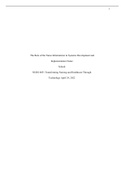Samenvatting
Summary Week 4 Strategic Management - BMZ2025: Entrepreneurial Management in Healthcare
- Instelling
- Maastricht University (UM)
Week 4: Strategic Management. Alle artikelen uitgewerkt aan de hand van de leerdoelen. Week 4: Strategic Management. All articles elaborated on the basis of the learning objectives.
[Meer zien]











